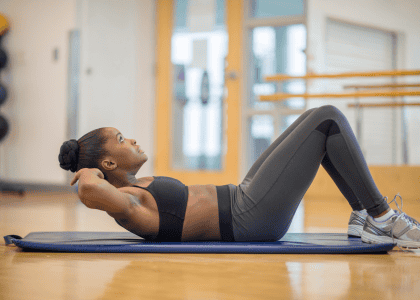Why You May Need to Do Sit-Ups Postpartum: Debunking Myths and Embracing Core Strength

By Dr. Norah Whitten, PT
Introduction: Challenging the Postpartum Core Exercise Myths
For many postpartum moms, the thought of doing sit-ups can trigger fear and hesitation. With so much advice floating around—from well-meaning friends to social media influencers—it’s easy to believe that sit-ups might be harmful after giving birth. However, avoiding core exercises altogether can hinder recovery and even contribute to long-term weakness. The truth is, a strong, functional core is essential for postpartum recovery, and sit-ups, when done correctly, can play a vital role.
While caution is important, it’s equally critical to understand that avoiding core work altogether can lead to prolonged weakness, poor posture, and even issues like leaking, prolapse or back pain.
Dr. Norah Whitten
The Problem: Why Do So Many Avoid Core Exercises Postpartum?
Many postpartum women are hesitant to engage their core muscles, especially with exercises like sit-ups. Much of this stems from widespread myths, such as the idea that sit-ups could worsen diastasis recti (ab separation) or harm the pelvic floor.
While caution is important, it’s equally critical to understand that avoiding core work altogether can lead to prolonged weakness, poor posture, and even issues like leaking, prolapse or back pain.
Misconceptions around sit-ups often arise from generalized advice. It’s not that sit-ups are inherently bad—it’s about how they’re performed and whether they are suitable for your specific condition. For example, if sit-ups are done with excessive momentum or improper technique, such as the abdominal muscles pushing out vs drawing in, they can indeed cause issues. However, when executed with proper form (meaning the abdominals are drawing in) they can be an excellent tool to restore core strength.
Key Insights: How Sit-Ups Can Support Postpartum Recovery
- Engaging the Deep Core: Sit-ups, when performed correctly, can activate the deep core muscles (the transverse abdominis) as well as the rectus abdominis (the “six-pack” muscles). Both of these muscle groups are crucial for stabilizing the trunk and supporting everyday movements.
- Practical Core Strength: In daily life, your core doesn’t just hold still—it moves, twists, and bends. Sit-ups mimic these natural movements- like sitting up from the couch while holding your baby, reaching over the crib to grab your toddler and carrying as many grocery bags from the car as possible to only take one trip (I know I’m not the only one out there who does this!). Using sit ups and sit up variations help to build functional strength that translates into real-world activities.
3. Supporting Diastasis Recti Healing: Contrary to popular belief, engaging the rectus abdominis (the muscle targeted during sit-ups) can aid in bringing the abdominal muscles back together when done under proper guidance. It’s not about avoiding all movement but rather controlling the movement effectively and strengthening ALL core muscles.

Common Mistakes to Avoid When Doing Sit-Ups Postpartum
- Using Excessive Momentum: When the upper body is flung forward without control, it reduces core engagement and increases the risk of injury.
- Over-Crunching: A sit-up should not involve collapsing into the chest or excessive crunching at the bottom of the rib cage. Instead, visualize sitting up and over an imaginary beach ball to maintain a long torso.
- Bulging of the Abdomen: If the belly bulges outward during a sit-up, it may indicate that the deep core is not properly engaged.
- Ignoring Pain Signals: Any pain or discomfort, especially in the pelvic floor or lower back, is a sign to adjust the exercise or consult a professional.
Actionable Steps: How to Safely Incorporate Sit-Ups into Your Routine
- Practice Engage the Deep Core First: Practice deep core activation through breathing exercises and gentle core engagements while on your back or in an all-fours position before attempting sit-ups.
2. Start with Crunches: Begin by lying on your back with knees bent. Focus on small, controlled movements where you lift just your head and shoulders off the ground, still thinking about crunching up and over a beach ball
3. Use an Ab Mat: Placing a small, rounded mat under your lower back can help fill the space between your spine and the floor, reducing strain. If you don’t own an Ab mat you can try rolling or folding a towel
4. Assist with a Band: If a full sit-up is too challenging, hold onto a resistance band attached to a stable anchor to help guide your movement.
5. Combine with Other Core and Hip Exercises: Build a well-rounded routine that includes hip bridges, modified planks, and gentle twisting movements to engage the entire core.
Watch the video below to see these tips & cues in action.
When to Avoid Sit-Ups Postpartum
There are situations where sit-ups may not be appropriate, such as:
- If there is significant diastasis recti and the abdominal muscles cannot create tension without doming or bulging.
-
- If pelvic floor issues are present, such as prolapse or incontinence and you have not received professional guidance.
-
- If pain arises during or after the movement, indicating the need for a more tailored approach.
Conclusion: Embrace Core Strength with Confidence
Sit-ups aren’t the enemy of postpartum recovery—in fact, they can be an important part of building a strong, resilient core. The key lies in listening to your body, focusing on proper form, and seeking professional guidance when needed.
At Functional Phyzio in Durham, NC we specialize in performance-based physical therapy that helps you safely regain strength and confidence postpartum. Whether you’re running or biking along the Tabacco trail or chasing your little ones at the park, a strong core will support you every step of the way.
Ready to take the next step? Reach out to us today to schedule a consultation and learn how we can support your postpartum journey with personalized, expert care!
About Dr. Norah Whitten, PT. Dr. Norah is not only a physical therapist, but also an athlete, coach and mom. Norah grew up a competitive athlete, specifically as a high level gymnast and diver. After sports Norah knew she needed a way to fulfill her competitive outlet and found CrossFit while in PT school. Norah utilizes the movement patterns and philosophies of functional fitness to get her patients the outcomes they deserve and help them become stronger than they ever thought possible.
Spread the word
Medical Disclaimer: All content found on the HER Health Collective Website was created for informational purposes only and are the opinions of the HER Health Collective experts and professional contributors. The Content is not intended to be a substitute for professional medical advice, diagnosis, or treatment. Always seek the advice of your physician or other qualified health providers with any questions you may have regarding a medical condition. Never disregard professional medical advice or delay in seeking it because of something you have read on this Website. If you think you may have a medical emergency, call your doctor, go to the emergency department, or call 911 immediately.
